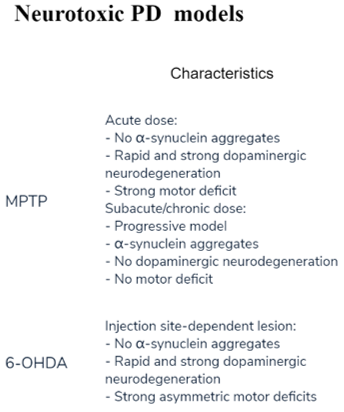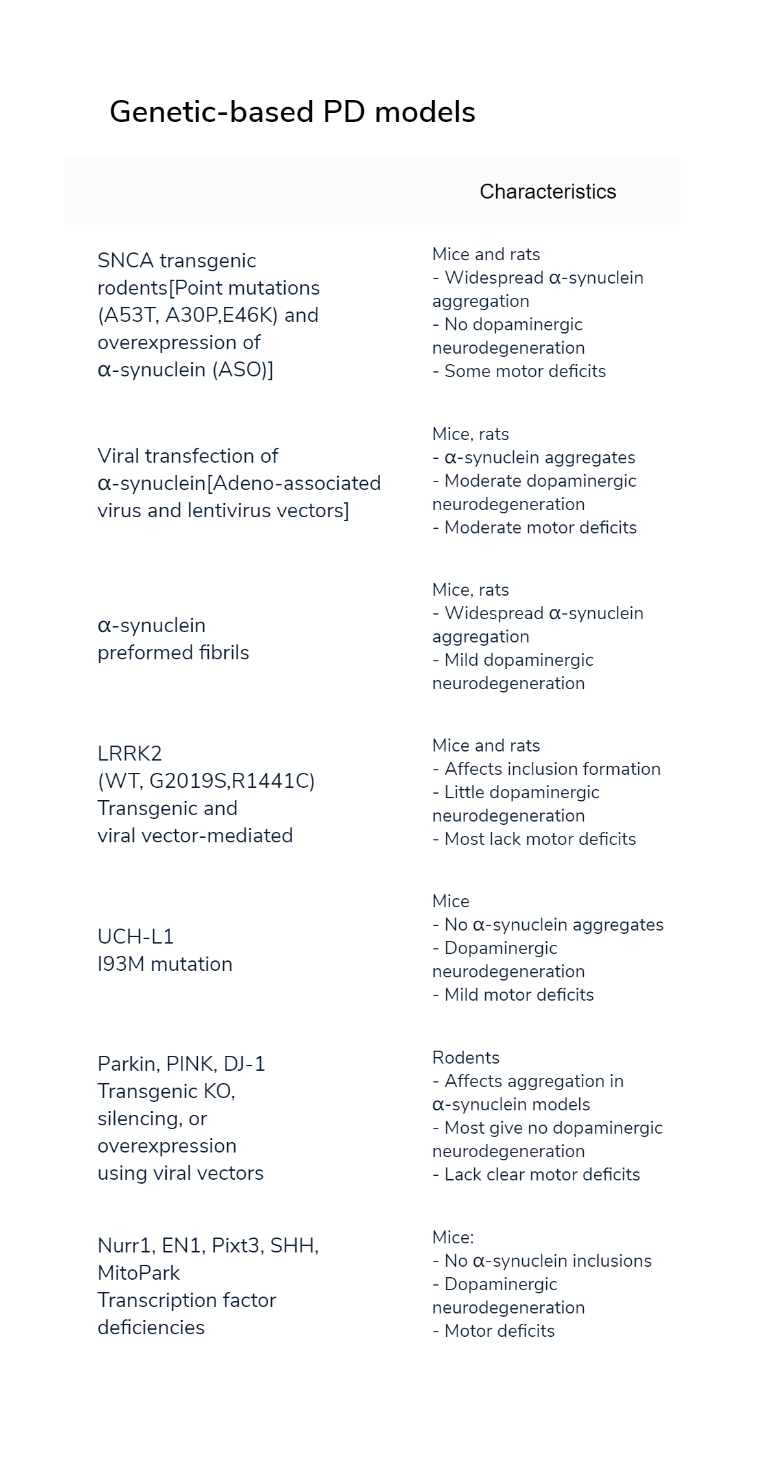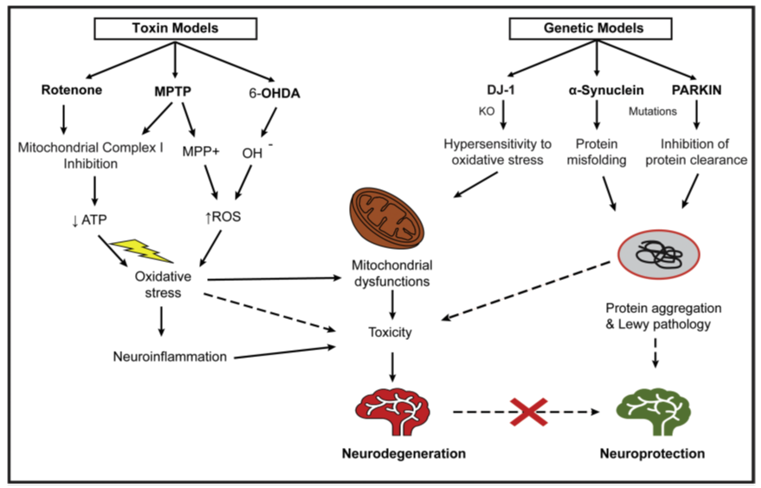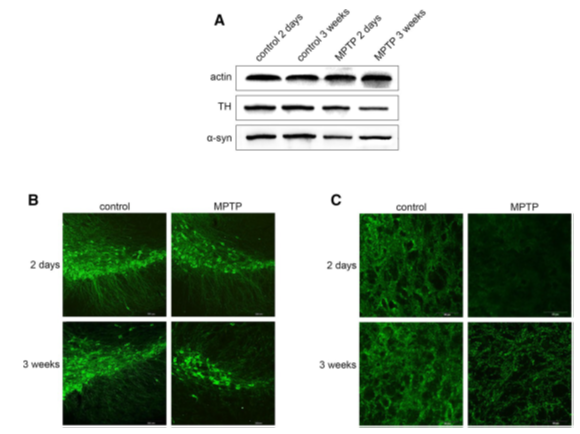Parkinson's Disease Models

Parkinson's disease (PD) is the second most common neurodegenerative disorder characterized by loss of nigrostriatal dopaminergic neurons and aggregation of the α-synuclein-rich inclusions called Lewy bodies and Lewy neurites. PD's characteristic symptoms are progressive motor deficits, including bradykinesia, tremor, akinesia, postural instability, rigidity, and gait difficulties. Non-motor symptoms, including depression, anxiety, sleep disturbance, cognitive decline, and anosmia, are prevalent in PD patients and often occur before motor symptoms(Konnova & Swanberg, 2018).
Although around 10% of all PD cases have a monogenic origin, most are idiopathic, with multiple environmental and genetic risk factors. Similar to the etiology, PD's clinical phenotype is heterogeneous. In comparison, the motor and non-motor symptoms are clinically detectable human brain pathology. Thus, increasing demand for experimental models to deepen our understanding of this multifaceted disease. The heterogeneity of PD etiology and pathology requires various models to replicate different aspects of PD in animals(Foltynie et al., 2002).
Creative Bioarray focuses on drug research and development services and helps customers assess the drug efficacy and study the associated pathological mechanisms of Parkinson's disease by in vivo/vitro PD model.
Parkinson's disease models:
Neurotoxins induced PD models:
- 6-Hydroxydopamine(6-OHDA)
- methyl-4-phenyl-1,2,3,6-tetrapyridine (MPTP)
Acute exposure to neurotoxins induces motor deficits and rapid nigrostriatal dopaminergic cell death by disrupting mitochondrial function and increasing oxidative stress, while chronic administration of neurotoxins induces progressive models, including alpha-synuclein (α-synuclein) aggregates.
Genetic-based Parkinson's disease models:
- α-synuclein and transgenic models
- Viral vector-mediated models
Genetic-based Parkinson's disease models include SNCA, LRRK2, UCH-L1, PRKN, PINK1, and DJ-1 and manipulation of dopaminergic transcription factors.

SNCA
Aggregated α-synuclein protein is the main component of Lewy bodies in PD patients. SNCA was the first to be linked to familial PD(FAD). Three autosomal dominant SNCA point mutations have been identified: E46K, A53T, and A30P.
Viral transfection of α-synuclein
Apart from transgenic strains, viral vectors can induce α-synuclein overexpression(Dawson et al., 2010). This method's advantages include targeting the nigrostriatal system, the induction of pathology in adulthood, and the possibility to adjust the dosage. Lentivirus (LV)-based vectors and Recombinant adeno-associated virus (rAAV) have been used to transfer SNCA in rodents(Van der Perren et al., 2015).
LRRK2
LRRK2 mutations display autosomal dominant inheritance but incomplete and varying penetrance, depending on the population. This means that not all mutation carriers will develop PD(Alessi & Sammler, 2018).
UCH-L1
Mice with mutated UCH-L1 display a mild reduction in locomotion, dopamine depletion in the striatum, and reduced dopaminergic neurons in the SNpc, without α-synuclein inclusions(Setsuie et al., 2007).
PRKN, PINK1, and DJ-1
Autosomal recessive mutations in PRKN (Parkin), PINK1, and DJ-1 have also been linked to FAD. There are over 100 known mutations of PRKN, and it is the most commonly mutated gene in early-onset PD (50% of familial and 20% of idiopathic early-onset cases)(Lücking et al., 2000).
Pitx3, Nurr1, EN1, SHH, c-Rel
Pituitary homeobox 3 (Pitx3), nuclear receptor-related 1 protein (Nurr1), engrailed 1 (EN1), sonic hedgehog (SHH), and c-Rel are all transcription factors that play an essential role in the maintenance and development of the dopaminergic nigrostriatal system(Blesa & Przedborski, 2014).

 Figure 1. PD models(Raza et al., 2019)
Figure 1. PD models(Raza et al., 2019)
Our capabilities
- Establish models with a high success rate and suitable for a specific project
- Behavioral testing
- Neuronal Morphology Evaluation
- Neurobiochemical evaluation
- Histopathology assays
- Mechanism/signaling pathway studies
- Biomarkers discovery
Creative Bioarray provides these powerful and versatile tools for PD basic research to help our customers understand more about the underlying mechanisms in the progression of PD.
Study Example
 Figure 2. MPTP influences TH and α-syn expression in the SN. (A) WB of TH and α-syn expression. (B) IF staining for TH in the SN. The scale bar is 200 μm. (C) Representative IF staining forα-syn in the SN. The scale bar is 50 μm. TH--tyrosine hydroxylase, α-syn--alpha-synuclein, SN--substantia nigra, WB--western blot, IF--immunofluorescence(Lai et al., 2018).
Figure 2. MPTP influences TH and α-syn expression in the SN. (A) WB of TH and α-syn expression. (B) IF staining for TH in the SN. The scale bar is 200 μm. (C) Representative IF staining forα-syn in the SN. The scale bar is 50 μm. TH--tyrosine hydroxylase, α-syn--alpha-synuclein, SN--substantia nigra, WB--western blot, IF--immunofluorescence(Lai et al., 2018).
With good skills and experience in the PD research field, Creative Bioarray is trustworthy to evaluate your preclinical drug candidates in acute and chronic efficacy studies, such as natural compounds, small molecules, biologics, and RNA therapeutics. Additionally, Creative Bioarray understands how to help design the studies to obtain rapid and precise answers to meet our customers' needs. Our in vivo animal models can provide rapid screening of the potential neuroprotective agents for PD treatment.
Quotation and ordering
If you have any special needs or questions regarding our services, please feel free to contact us. We look forward to cooperating with you in the future.
References
- Alessi, D. R.; Sammler, E. LRRK2 kinase in Parkinson's disease. Science, (2018), 360(6384), 36-37.
- Blesa, J.; Przedborski, S. Parkinson's disease: Animal models and dopaminergic cell vulnerability. Frontiers in Neuroanatomy, (2014), 8, 155.
- Dawson, T. M.; et al. Genetic animal models of Parkinson's disease. Neuron, (2010), 66(5), 646-661.
- Foltynie, T.; et al. The heterogeneity of idiopathic Parkinson's disease. Journal of Neurology, (2002), 249(2), 138-145.
- Konnova, E. A.; Swanberg, M.. Animal Models of Parkinson's Disease. In T. B. Stoker & J. C. Greenland (Eds.), Parkinson's Disease: Pathogenesis and Clinical Aspects. (2018), Codon Publications.
- Lai, F.; et al. Intestinal Pathology and Gut Microbiota Alterations in a Methyl-4-phenyl-1,2,3,6-tetrahydropyridine (MPTP) Mouse Model of Parkinson's Disease. Neurochemical Research, (2018), 43(10), 1986-1999.
- Lücking, C. B.; et al. Association between early-onset Parkinson's disease and mutations in the parkin gene. The New England Journal of Medicine, (2000), 342(21), 1560-1567.
- Raza, C.; et al. Parkinson's disease: Mechanisms, translational models and management strategies. Life Sciences, (2019), 226, 77-90.
- Setsuie, R.; et al. Dopaminergic neuronal loss in transgenic mice expressing the Parkinson's disease-associated UCH-L1 I93M mutant. Neurochemistry International, (2007), 50(1), 119-129.
- Van der Perren, A.; et al. Viral vector-based models of Parkinson's disease. Current Topics in Behavioral Neurosciences, (2015), 22, 271-301.
Explore Other Options